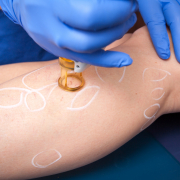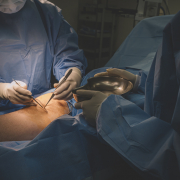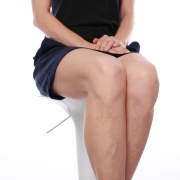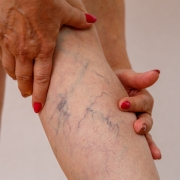What Is Vein Disease?
Vein disease is a chronic condition that encompasses a range of disorders. Over time it can cause a number of uncomfortable symptoms and conditions such as varicose veins and spider veins. The good news is that there are a variety of treatments options available that can be customized to your specific condition to alleviate symptoms and prevent it from worsening.
The Role of Veins
Veins are part of the vascular system and are the blood vessels which are responsible for carrying blood towards the heart – unlike the arteries which carry blood away from the heart. Most of our veins also carry deoxygenated blood from our tissues, with the exception of the pulmonary and umbilical veins. In order for our veins to successfully perform this function, each vein is equipped with a series of one-way valves that keep blood flowing in the right direction, towards the heart, and then close once the blood has passed through them.
Veins located close to the surface of the skin are called superficial veins and the veins found in the muscles of the arms and legs are called deep veins. Perforator veins carry blood to the deep veins from the superficial veins. Vein disease can occur in any of these types of veins and most commonly involve the veins in the legs. This is because it is much harder to work against gravity to pump blood from the feet to the heart, meaning the veins are more likely to become damaged and diseased.
If the walls or the valves of veins weaken, or become damaged, it can prevent the circulatory system from functioning properly and cause blood to pool in a segment of the body. With increasing dilatation of a damaged vein, the blood begins to flow backwards down the leg leading to increased pressure inside the vein resulting in a condition known as chronic venous insufficiency. Over time, increased pressure can lead to more stretching and twisting of the veins, sluggish blood flow, potential blood clot formation, and result in vein-disease disorders, such as spider veins, varicose veins, skin rashes, chronic inflammatory skin conditions, and ulcer formation. If left untreated, continued progression of vein disorders may lead to even more serious health issues such as deep vein thrombosis and pulmonary embolism.
Symptoms of Vein Disease
For some, there can be visible signs of vein disease such as varicose veins and spider veins, but for other individuals, there may be no obvious visible symptoms, and they may instead experience uncomfortable symptoms that can affect overall quality of life. Symptoms of vein disease may include:
- Swelling or heaviness in the lower legs
- Legs that tire easily
- Aching legs
- Itching or burning around the affected veins
- Cramping or restless legs
- Visible spider or varicose veins
- Persistent, irritating rash on the leg
- Changes in skin color or appearance of sores or ulcers
- Peripheral neuropathy or numbness and tingling in the feet and ankles
- Loss of skin texture of underlying tissue around the ankle
Symptoms can mean a vein condition is becoming more severe and should be evaluated by a qualified vein specialist quickly.
Spider and Varicose Veins
Spider veins are usually small and thin red or purple lines that are formed by the dilation of a small group of blood vessels located close to the surface of the skin. They can appear anywhere on the body, but are most commonly found on the legs and face. Oftentimes, spider veins develop because of abnormalities in the underlying veins which are under high pressure. Spider veins can also result from sun damage, hormonal changes, or an injury.
Varicose veins are much larger in size and deeper under the skin. They usually develop in the legs, bulge and twist in appearance, and can often be seen and felt just under the surface of the skin. Some varicose veins are not visible but may cause symptoms of aching, cramping, heaviness, itching around the veins, swelling, restless leg symptoms, pain after sitting or standing for a long time, and skin discoloration.
Treatment Options
Treatment may be necessary to prevent a vein disorder from worsening and to improve the appearance of the skin. There are a number of treatment options available which range from conservative treatments and minimally invasive procedures to surgery, depending on the severity of your condition.
Specialist Vein Care in Kansas City, MO
If you have symptoms of vein disease, speak to the Missouri Vein Specialists to find out which treatment would be best for you. Experienced vein specialist Dr. Scott Darling, has the expertise to treat the full spectrum of vein disease. For more information about the treatments we provide, or to make an appointment, call us today at 816-792-3400 to schedule your vein screening.












